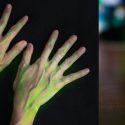You’re 402 km (250 mi) above the Earth in the International Space Station, and you hear a loud BANG! A piece of space debris just hit the ISS, and all of the alarms are going off. Everything is malfunctioning. Fear sets in, as smoke begins to fill the station. There’s a good chance you’ll die during this mission.
You just want to get home safely. But first, you’ll need to get out of the space station alive.
The International Space Station, or ISS, is a live-in laboratory that’s bigger than a six-bedroom house. And it orbits around the Earth every 90 minutes. There are two sides to the ISS, a Russian side and an American side. You and five other crew members conduct research 35 hours a week, and when you’re not working, you can enjoy viewing the Earth from the Cupola, a 360-degree window.
But when you’re living in an aluminum can, high above the Earth, problems can get really bad, fast. So this might be your last trip to space. Why could a material that’s like Silly Putty save your life?
Why does it help to have a good sense of smell? Should you try to fix the damage, or evacuate? Over 16,000 objects bigger than a small grapefruit are orbiting the Earth, so it was only a matter of time before something hit the ISS. Bad luck, it happened while you’re up here.
Impacts can damage crucial parts of the station, putting your life and your crew’s in danger. So it’s up to you to take care of everything that goes wrong. What you should do?
STEP 1: STAY ALERT
There are three major dangers to the ISS. They’re being hit by debris, fire, and toxic spills. So, always be aware of your surroundings. Since you heard something hit the space station, grab a repair kit, and go check for damage. And make sure you’re dressed for the occasion. Don’t ever try to clean up a toxic spill, or stop a crisis, without putting on protective gear first.
STEP 2: ACT QUICKLY
Once you’re alerted to the problem, assess the situation. The ISS could have been hit by a meteor strike and start leaking air. The bigger the hole, the faster the air will flow into space, and the less time you’ll have to fix the damage. Isolate the Russian and U.S. parts of the station, so you can quickly figure out where the leak is. If the leak is small, patch it with the material like Silly Putty in the repair kit. Then work with Mission Control to repressurize the module.
But if the damage is too severe, get out of there. You and your crew will need to get in the Soyuz escape capsules. And stay in contact with Mission Control for as long as you can. They can give you info about the hit, and how to fix the damage, or order you to de-man the space station.
STEP 3: RELY ON YOUR SENSE OF SMELL
If you smell any ammonia, or other toxic materials, put on an oxygen mask immediately, and push the alarm button to start the ISS automatic shut down procedures. A toxic spill is dangerous, and unfortunately it’s very likely to happen. You must outrun the cloud of ammonia gas, evacuate the area, and isolate the areas affected by the spill.
STEP 4: CHECK CAREFULLY FOR TINY, BLUE FLAMES
A fire on the space station wouldn’t look like a fire on Earth. Here, flames are blue at the bottom, yellow on top, and they point upwards. But on the ISS, a fire would look a little blue orb on the end of a wick. And on the ISS, flames wouldn’t just spread upward. They could go in any direction, so you’ll have to look carefully to find them.
First, turn off the ventilation system, so the fire spreads slower. Then, shut off the power to the unit that’s on fire. On the U.S. side of the space station, use a fire extinguisher. But on the Russian side, put out fires with soapy water.
STEP 5: WORK TOGETHER
There is no I in team. Act as a team, and communicate with your crew members. And stay in contact with Mission Control for as long as you can. They can give you info that will help you to fix the damage.
However, do not jump into extreme danger to save a crewmate, as both of you could have serious injuries or die. Everyone on the space station is crucial to the team. Sacrificing yourself could be devastating to the whole crew.
STEP 6: FLOAT AWAY
If you and your crewmates can’t fix the issue, float away from the affected area immediately. Head to the opposite side of the space station, and isolate any areas that have a fire, a toxic spill, or are losing air. If it’s so bad that everyone has to evacuate, don’t worry, as the ISS is equipped to run itself.
Sources
- “Chris Hadfield gets tough on Space Station spills”. youtube.com
- “Toxic Spill On The International Space Station”. Young, Kelly. 2021. New Scientist.
- “Space Station Maneuvers To Avoid Debris – Spacenews”. Foust, Jeff. 2020. Spacenews.
- “The ISS astronauts had one heck of a night last night”. Wehner, Mike, Andy Meek, and Chris Smith. 2020. BGR.
- “Why astronaut Chris Hadfield isn’t afraid of death”. Powell, Corey. 2018. NBC News.
- “How Much Of A Threat Is Space Debris To The ISS?”. 2021. Forbes.
- “What Are The Greatest Dangers To The ISS?”. 2021. Forbes.



























